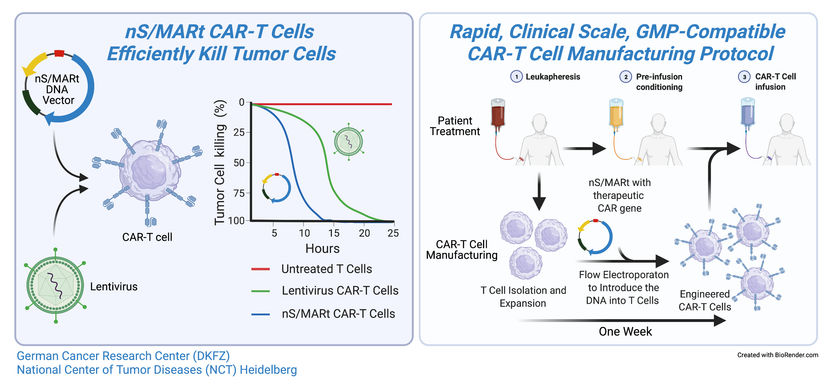3D model of human placenta developed
The placenta is the organ connecting mother and embryo. Its main functions are the exchange of nutrients, gases and metabolic products and the production of hormones and other substances essential for embryonic development. Placental malfunctions are the main cause of pregnancy complications and can lead to miscarriage and other serious disorders that endanger both mother and child. So far, the mechanisms underlying these disorders remain largely unexplained, not least because, up until now, there has been no reliable human cell culture model system.
MedUni Vienna researchers have now successfully developed a 3D model of the human placenta. The 3D "in vitro" model of the early human placenta was produced in a collaborative project involving the research groups of Martin Knöfler from MedUni Vienna's Department of Obstetrics and Gynecology (Division of Obstetrics and Gynaecology) and Paulina Latos from MedUni Vienna's Center for Anatomy and Cell Biology.
First organoid model of the placenta – based on other tissue culture models
"Over the last few years, 3D tissue culture models, called organoids, have rapidly been established for many different human organs. In most cases, these organoids consist of only a few cell types from the respective tissue and therefore have a simpler structure than the original organ," explain the researchers. Working on this basis, the team from the Medical University of Vienna managed to develop an organoid model of the placenta, consisting of the prevailing placental cell population, so-called trophoblasts.
Knöfler and Latos explain: "As a puretrophoblast organoid without blood vessels or connective tissue components, this model mirrors the trophoblast-specific placental structure in a Petri dish." This was done by optimising the culture conditions that had already been successfully applied in organoid models of other tissues.
A significant advantage of the placenta organoids is their capacity for self-organisation, self-renewal and constant growth, stress the MedUni Vienna scientists, since they contain both stem cells and progenitors. Moreover, these 3D structures also contain the three main cell types of the human trophoblast population.
The MedUni Vienna researchers were able to underpin the groundbreaking advantages of this organoid system with a study substantiating the role of the WNT signaling pathway (which is crucial for development and growth of many tissues) in self-renewal and differentiation of the trophoblast organoids. The organoid model system can also be pharmacologically and genetically manipulated. This opens up new possibilities for studying physiological and pathophysiological processes of the human placenta.
"The fact that there were no self-renewing cell culture model systems available for the human placenta made it difficult, if not impossible, to study the causes of malfunctions. Establishment of the placenta organoid system will improve this situation significantly and will help advancing drug development and consequently medical treatments for dangerous gestational disorders," emphasises Knöfler, one of the leading international experts in placental research and last author of the study.
Original publication
“Self-Renewing Trophoblast Organoids Recapitulate the Developmental Program of the Early Human Placenta”; Sandra Haider, Gudrun Meinhardt, Leila Saleh, Viktoria Kunihs, Magdalena Gamperl, Ulrich Kaindl, Adolf Ellinger, Thomas R. Burkard, Christian Fiala, Jürgen Pollheimer, Sasha Mendjan, Paulina A. Latos and Martin Knöfler; Stem Cell Reports; 2018
Most read news
Original publication
“Self-Renewing Trophoblast Organoids Recapitulate the Developmental Program of the Early Human Placenta”; Sandra Haider, Gudrun Meinhardt, Leila Saleh, Viktoria Kunihs, Magdalena Gamperl, Ulrich Kaindl, Adolf Ellinger, Thomas R. Burkard, Christian Fiala, Jürgen Pollheimer, Sasha Mendjan, Paulina A. Latos and Martin Knöfler; Stem Cell Reports; 2018
Organizations
Other news from the department science

Get the life science industry in your inbox
By submitting this form you agree that LUMITOS AG will send you the newsletter(s) selected above by email. Your data will not be passed on to third parties. Your data will be stored and processed in accordance with our data protection regulations. LUMITOS may contact you by email for the purpose of advertising or market and opinion surveys. You can revoke your consent at any time without giving reasons to LUMITOS AG, Ernst-Augustin-Str. 2, 12489 Berlin, Germany or by e-mail at revoke@lumitos.com with effect for the future. In addition, each email contains a link to unsubscribe from the corresponding newsletter.
Most read news
More news from our other portals
Last viewed contents

Molecular machine in nano cage - What a toy: a tiny gyroscope that would fit in a human cell and that can be controlled from the outside
Fear_of_youth

Special Software Enhances Accuracy of Genome Annotation for Animals and Plants - "BRAKER3 marks a significant development in bioinformatics and provides academics all over the world access to a high-performance tool for genome annotation"
Blinking neurons give thoughts away
List_of_maize_diseases

In the active centre of carbon dioxide conversion - Scientists reveal the features of efficient carboxylase enzymes

Discovery of a new reprogramming mechanism for tumor cells

From pasture to patient: Scientists distill cow’s milk into nano-capsules for drug delivery - New method to purify exosomes from cow's milk for nano-sized drug delivery capsules - Virginia Tech spin-out company formed






















































